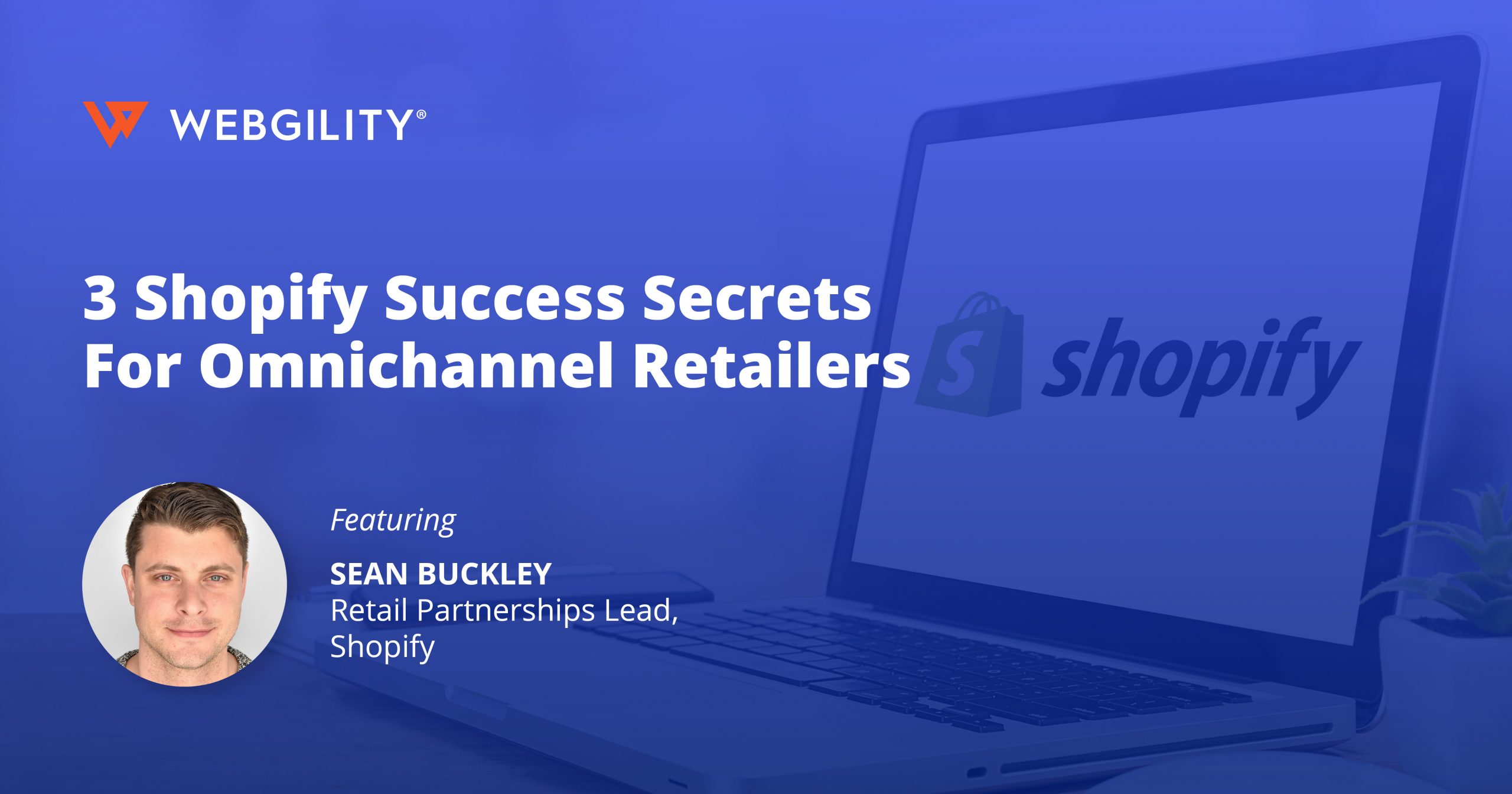
3 Shopify Success Secrets for Omnichannel Retailers
Contents
Today’s retail marketplace is changing at a breakneck speed. Savvy sellers are embracing an omnichannel commerce strategy that unifies the in-store and online experience to meet consumer demands. Forward-thinking retailers are realizing that shoppers who have been served up a unified customer experience are a lot more engaged, show increased loyalty, and—get this!—spend considerably more.
Unfortunately, offering a seamless customer experience through multiple physical and digital channels is no walk in the park. That’s why we asked Sean Buckley, Retail Partnerships Lead at Shopify, to share retailers’ top omnichannel success secrets with us in a recent webinar.
If you joined us for the webinar, you can skip ahead to the end to find Sean’s answers to attendee questions he didn’t get to during our scheduled time together. If you missed it, you’re in luck—we have his omnichannel strategy tips and profitability hacks below in both video and transcription format. Enjoy!
About the presenter and host:

Sean Buckley
Retail Partnerships Lead, Shopify
Shopify is an all-in-one commerce platform that powers over 1,000,000 businesses worldwide. Sean works in Shopify’s Retail Practice, where his team is on a mission to improve commerce for everyone. His primary focus is helping merchants unify their in-store and online sales with tools that set them up for the future of retail. As such, Sean obsesses over the problems merchants face day to day—taking a “merchant first” approach to every project.

Anati Zubia
Vice President of Marketing, Webgility
Webgility is the number-one ecommerce accounting automation platform for high-growth online retailers and accounting professionals. Anati leads Webgility’s Marketing team, and is dedicated to helping customers, partners, and industry influencers prepare for the next generation of ecommerce by increasing productivity, predictability, and profitability.
3 Shopify Success Secrets for Omnichannel Retailers
Sean Buckley: Today, I’m going to talk about omnichannel, for the most part, and the three Shopify success secrets for omnichannel retailers. And I didn’t just leave it at the three secrets; we have a couple other things in there that our successful merchants do in the omnichannel world that set them up for success. First off is the omnichannel opportunity. The customer expects a seamless buying experience across channels. Retail businesses that deliver will take market share, earn loyalty, and scale faster. 2030 has been pulled forward to the present. The last year accelerated nearly a decade of e-commerce evolution in just a few months. While the world is once again open for business, it’s still not business as usual.
In a matter of days, traditional brick-and-mortar merchants began selling online for the first time, from ecommerce product bundles to curbside pickup. An omnichannel approach allowed these retail businesses to continue selling despite lockdowns, travel bans, and forced retail closures. The omnichannel experience is more than giving customers places to buy. The true power of omnichannel is realized when channels work together in harmony to immerse consumers in a highly personalized experience that also respects the stage of the buying cycle that the consumer is in. The omnichannel experience should feel so seamless that the customer can skip from one channel to another without realizing their movement down your sales funnel as a merchant.
I have a quote here from Francisco Rivas, the leader of Google’s retail sales team:
“As you start to understand how people are being driven to your stores, the next thing you have to do is get an idea of what your target market is, and what they look like. You can get a greater sense of the person who’s using your brand and your products. As they touch different channels, you learn more about them and their habits.”
The last year magnified the fact that shoppers prefer omnichannel shopping. They’ll use as many as a dozen channels or devices before making a purchase decision. And those touchpoints involve hopping between the digital and physical worlds. What they expect and need from you varies widely by channel depending on what stage of the customer journey they’re in. During the last year, the trend toward buy online, pick up in store (BOPIS), also known as curbside pickup, increased by 62%. Offering omnichannel shopping and fulfillment can drive sales in a new commerce future as customers become accustomed to picking up orders that they once might have paid to ship.
Omnichannel Retailing Defined
Sean Buckley: What is omnichannel retailing? Omnichannel retailing is a fully integrated approach to commerce that provides shoppers a unified experience across all channels or touchpoints. This means in-store shopping, in-person shopping or offline, e-commerce marketplaces, mobile websites or your online webstore, applications, social marketing, retargeting and sales, messaging and SMS, and deeply personalized email marketing.
Omnichannel retailing doesn’t need you to be everywhere, it just needs you to be everywhere that your customers are. And it involves integrating each touchpoint to offer customers exactly what they need, when they need it, and on any device. The lesson is that commerce is rapidly becoming channel-agnostic, which gives customers the choice of where to purchase. It becomes your job to optimize their experience on the most relevant sales channels based on your target customers’ shopping behavior.
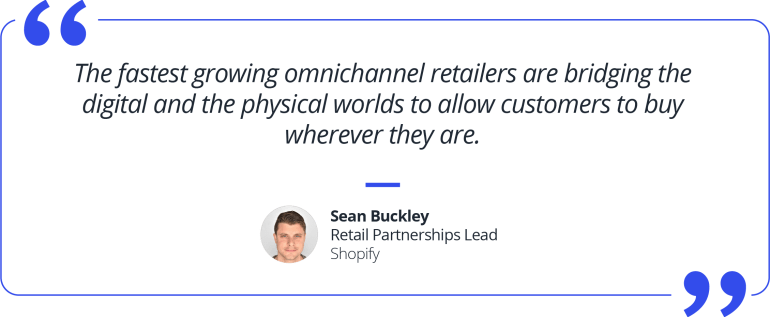
And so today I’m going to focus on how a strong omnichannel strategy and tactics can be applied not just to what channels your customers purchase from, be it online, in-store, or in an app marketplace, but also on how you can craft an omnichannel strategy to maximize the way your customers get to the point of purchase. Let’s take a look at some subject matter on why crafting a unified customer experience is crucial to the omnichannel success and secrets to offering a seamless brand journey in both the digital and physical worlds.
A Unified Customer Experience Is Key to Omnichannel Success
Sean Buckley: Why is a unified customer experience crucial to omnichannel success? Number one, up to 73% of shoppers—that’s three in four shoppers—use multiple channels. That means they might be purchasing in-store and online from your brand or from your store, or through social channels. These shoppers, they take a non-linear path to purchase. And non-linear means that they might start investigating on one channel, and then move to the next, do some more investigation and research. They can be influenced both positively and potentially negatively through that experience. But their path to purchase wasn’t as simple as walking by your store display, seeing something in the window, walking inside, and buying.
Shoppers can go from offline to online and vice versa. It can be a mix of the two. This is channel hopping, and it’s the new shopping norm. Modern solutions help facilitate this flow. A good example is having your point of sale integrated with your online store. A customer can make a purchase in person. Next, you can market cross-sell items to that customer in a personalized email campaign where the customer can check out via your online store. The in-person purchase started a customer journey that led to a cross-sell purchase happening online. That’s a repeat purchase from your customer, increased revenue for you, the merchant. And you were able to increase your sales without having to drive the customer back to a single channel. And this is the ability to reach your customers everywhere.
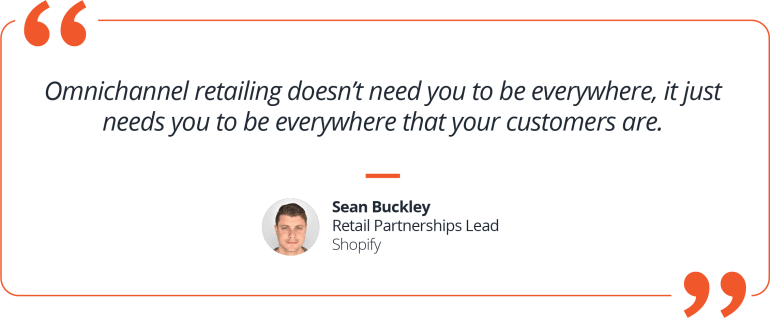
It’s also important to have an understanding of general customer behavior. Here we have five stages of a traditional marketing funnel and how your customer behavior looks in that funnel. The first stage is awareness. This is where we create awareness of the brand or the store. This includes things like PR, radio, print advertising, out of home, word of mouth, online ads, pay per click in the digital world, and email. Second stage: consideration, social ads, reviews, blogs, media, direct email again. The third stage is the conversion stage. This is when the customer actually makes the purchase. And this includes online shopping, in-person shopping, marketplaces, so Walmart or eBay if you’re dialed into those marketplaces, as well as mobile shopping. The next stage, we have retention. This is where you have community forums and frequently asked questions, knowledge bases, things like that.
And then finally, advocacy. This is a very important stage because this is where you drive repeat purchases. This is where your customers turn from being just a one-time visit to a multiple-time visit and become much more valuable to your business. Those customers also become advocates for your business. They make referrals to their friends: “You should check out this spot, you should check out that spot or see this product, I had a great experience,” etc. And maybe they’ll do that through their social communities via social media. This is word-of-mouth marketing, social proof, and it builds brand or store loyalty. But you have to notice that the purchase decision, that purchase stage, it’s influenced long before a shopper becomes a customer. It’s crucial to be present as an omnichannel merchant in pre-purchase channels like online ads or customer review sites. This is an understanding of how customers find your checkout, insights on who your target shoppers are. Now, that brings us to some of the fun stuff.
Secret #1: Successful Omnichannel Merchants Use Insights to Understand the Customer Journey
Sean Buckley: The key point here is understanding your customer’s journey. How are some of the best merchants building awareness, educating customers, persuading purchase decisions, and retaining long-term customers? Well, those actions are actually stages of the customer journey, and they each have a different goal. And each stage needs specific messaging on each channel. And that’s something I’ll touch on a little later. Here’s an example of a customer journey. Shoppers discover new products through social and display ads. They start with a generic product category or local searches, and then they compare options. And this is them evaluating and researching. When they’ve narrowed their list, they do brand or store-related searches and seek reviews or referrals from friends. Next, they sign up for emails from the brand or store they’re evaluating and maybe access discounts or promotions.
And then finally, they make their purchase directly through an e-commerce site, app, or in-store. The takeaway here is that the majority of the buying decision happens before a customer walks in your store or visits your site. And they’ll interact with multiple touchpoints while they do that. It’s the zero moment of truth. And that’s a reference to the timeframe when somebody researches a product before deciding to buy it. Using omnichannel tools that provide you insight into your customer’s journey is a superpower that allows our top merchants to build an omnichannel strategy to provide maximum impact for their business. They’re using their omnichannel tools to understand the customer’s journey. How are your customers discovering your product in-store, and does it differ by area or demographic or age? Does that necessitate one strategy for one group of people or customers and a second for another? You can glean insights that answer these questions, and then make strategic investments in that part of the customer journey accordingly.
And that leads us to secret number two.
Secret #2: Successful Omnichannel Merchants Use Insights to Identify Top Conversion Paths
Sean Buckley: Here, the key is understanding the top conversion paths. Identifying where your customers come from prior to making a purchase on one of your channels is crucial. The goal here is to map your customer’s pre-purchase journey. In secret one, understanding your customer journeys. And number two is actually mapping those journeys so that you can understand: Where did the journey start? How many touchpoints did it take before the purchase was made? What were these touchpoints? And do you see a trend starting to emerge there? Are some touchpoints more impactful than others?
If a customer takes six touchpoints to get to your checkout, was there one touchpoint that is showing up on all of the customer journeys? Does it have more impact, and is that an insight that you should take action on? How are channels interacting with one another on the path to purchase? Did they start with an online ad and then go to your website and then buy something and then pick up in-store? Did they start with an online ad and then investigate on your website and then make an in-store purchase or check out on your website? Did they try something on and then decide to check out online? These are things that you can understand in that customer journey. And finally, is one path providing more revenue than others or higher transaction volume? These are things that will impact your bottom line.
These questions are the questions that top omnichannel merchants ask and seek to answer so they can build an informed strategy to maximize on their objectives. Example objectives could be increasing revenue, increasing return, or just higher transaction volume or average transaction volume. They map the conversion pathways and they’re able to weigh the value of one versus the other. When you use insights from your tools to map and understand your conversion pathway, you can see how your available channels interact along those paths. You want to identify the conversion paths that produce the most valuable customers and focus on the profitable paths to increase the quality of your customer base. You can go even deeper by segmenting customers from your most profitable paths based on how you might assess their lifetime value.
And this leads us into secret number three:
Secret #3: Successful omnichannel merchants use insights to segment and prioritize.
Sean Buckley: Creating buyer segments. Here’s how. You can create buyer segments based on the number of purchases existing customers have made. And so here’s a quick example that I’ve thrown up on the slide. You have your one-time buyer and that’s just one purchase; a repeat buyer, say two purchases; and then finally a local buyer, three-plus purchases. Now you could adjust these based on your own business rules. But what the ultimate goal is, is to get your customers to be in that loyal buyer 3X purchases group. Customers who are in that segment, they have a higher lifetime value to your business than customers who stay in the one buyer stage.
And by that I mean a customer has bought three times from you. They’ve now visited three times, so you’ve had three times the revenue and margin from that customer versus customers who might have only visited once. And so you can segment them and then begin to prioritize these customer groups with different tactics and different actions. These segments are examples that you can tailor to suit your sales volume and expectations. Our top merchants don’t just stop at the number of purchases when they segment—they layer in multiple factors like geography, age, and others to build a deeper understanding of who their customers are.
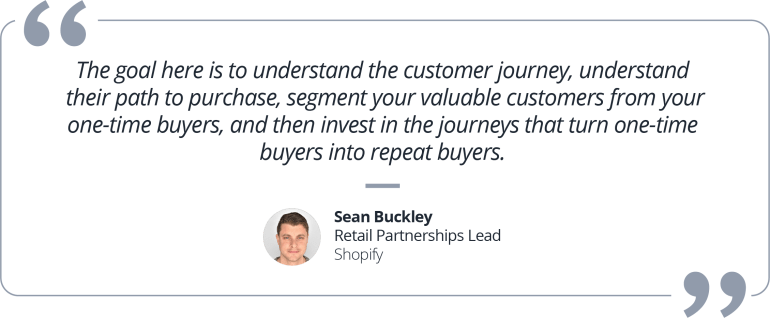
Success can be found in understanding the customer journey that was taken by your loyal buyer base, so that three-plus purchase base. And then building tactics to encourage more of that journey. Also, you will be able to experiment with different approaches to create journeys that encourage more one-time buyers to become repeat and then eventually loyal. The goal here is to understand the customer journey, understand their path to purchase, segment your valuable customers from your one-time buyers, and then invest in the journeys that turn one-time buyers into repeat buyers. More one-time buyers become repeat, eventually loyal. And this is achieved by accessing the data and insights an omnichannel solution can serve up to you as a merchant, versus a multichannel setup that isn’t sharing the data and has it siloed into different platforms.
You can see the exact path each individual customer took before buying. And this shows you how much each customer has spent. And top merchants are even looking at attribution to show the multiple devices, phones, and apps the customer uses through their journey, even when the purchase takes place in-store on the point of sale system. That means that your point of sale is interconnected with that first time that customer might have clicked on an Instagram ad that you served up to them on their phone. And you can see that entire path to purchase and the pathways that your most valuable customers are taking and apply tactics and invest in those pathways to amplify your most valuable customer base.
How Shopify Retailers Overcome Omnichannel Chaos
Sean Buckley: Now I’m going to look at how the fastest growing Shopify retailers are overcoming omnichannel chaos, building brand loyalty, and fueling sales. How are they growing? The fastest growing omnichannel retailers are bridging the digital and the physical worlds to allow customers to buy wherever they are. What does an example of this look like? A journey can start on social channels. Interested shoppers can click through to visit your online store, which immediately offers incentives to opt in to email marketing. An example of what an incentive could be is a time-bound promo code for something like shipping or a group of products that you might have in your store. And being time-bound promotes a sense of urgency to activate on that code. Opting in gives permission to receive marketing emails, and enables purchases across channels. For example, consumers can purchase via Facebook while marketing messages can drive traffic to the online store to shop new arrivals. But why stop at online? You can drive traffic to your retail store as well. Or both.
Customers can be targeted across multiple channels to experience your products in person at your retail location, which can offer curbside pickup for online orders. And what I mean by that is, you can actually have somebody shop in-store, and then if they don’t check out in person, you can email them that cart, and then remarket to them and then have them check out that item online at any time. To drive engagement across channels and increase conversions, you can invite customers to show off with user-generated content, pictures of their purchase, shared on social channels, and then tagging your store or your brand in it.
Here’s a powerful stat. User-generated content, including reviews, is being used by 84% of customers to make purchase decisions, and you can host it on your online store, or socials like Facebook and Instagram. After engaging with user-generated content, the customer can make purchase decisions natively on each of those channels. The fastest-growing omnichannel retailers are excellent at omnichannel marketing. I know that seems to go hand in hand if they’re great at marketing, then they’re probably great at driving traffic and converting sales. But I’ll take a look right now at what does that marketing actually look like? What tactics are they using?
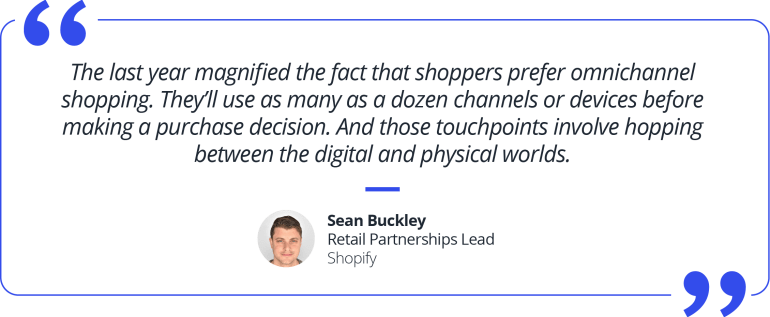
The omnichannel marketer understands that the aim of one campaign should blend smoothly into the next. Each touchpoint works together to deliver a cohesive tailored experience. Abandoned carts lead to email coupon codes. The coupon codes can be redeemed online or in-store. If they were shopping for something online, you can drive that traffic from that abandoned cart with the coupon code toward your store as well. In an integrated omnichannel solution, abandoned carts don’t have to live just online. If a customer is shopping in person and decides not to purchase something, that item can be remarketed to them. Perhaps coupled with a coupon to drive the customer to the online checkout. Retargeting ads remind prospects of those discounts, discounts that again can apply on any of your sales channels. Completed orders result in cross-sells, and even financing options for other products. Again, this isn’t limited to online purchases. An omnichannel solution that integrates in-store point of sale and online channels allows you to cross-sell online from purchases made in-store, and even the other way around.
For example, customers’ online purchase history is readily available on the point of sale. And that allows merchants to provide a tailored shopping experience right from their associates in-store. And this can be in the form of suggested products to cross-sell, tailored to that specific customer based on their omnichannel purchase history. These product recommendations are displayed to the store associate right on the point of sale at the point of purchase. That means that if somebody has been buying on Facebook, if they purchased from you from your online store, you can see that purchase history of that specific customer right on your point of sale and have your point of sale make suggested upsells or cross-sells to that customer to your store associate while they’re actually interacting with them. And you can have that work the other way around as well; in-store purchases can influence the cross-sell or upsell of their online checkout.
Tips and Tricks for Omnichannel Marketing
Start with micro-tailored messaging.
Sean Buckley: Treating customers differently is the hallmark of omnichannel marketing. For new visitors, the omnichannel marketer can start by subtly acknowledging where the visitor came from. The strategy here is to discern customer intent from their traffic source. For instance, if a new user came from Pinterest, as I have up here on the slide, you can acknowledge this with a special coupon for Pinterest visitors. It’s a welcome and relevant personal touch that builds on the micro-conversion the visitor has already taken. Clicking on your link from Pinterest moves them towards the macro conversion of becoming a buyer.
Don’t ask for the sale right away.
Sean Buckley: Instead, ask new visitors for their email by offering an irresistible incentive. Experiment with overlays that are triggered when a new visitor comes to your site. Not only does collecting emails reduce the amount of anonymous traffic your site might receive, it positions you better to send future emails and communications. Email also opens up a new marketing channel that often converts better, reduces customer acquisition costs, and that means it will yield a better return on your investment. Getting email addresses should be one of the omnichannel marketer’s top conversion goals because email can be a great place to test and better understand somebody’s complete user journey across your channels.
This ties back to that pre-purchase pathway. And understanding your most profitable pre-purchase pathway is one of the secrets to success. But also testing how to drive different customer cohorts to that profitable pathway is something that is really well done if you have their email contact.
Asking for email addresses serves two purposes:
- It helps identify anonymous users not identified by other means.
- For previously identified users, email opens up a new lower-cost marketing channel. You don’t have to pay for advertisements if you can just email them at a lower cost to your customer base.
The Dangers of Omnichannel Data Loss
Sean Buckley: Here are some tips for building a truly integrated commerce tech stack that leverages insights and maximizes profitability. Enable commerce everywhere—the omnichannel retailer looks to utilize a tech stack that extends their storefront across multiple channels, including in-person via retail storefronts and point of sale, online via e-commerce and marketplaces, social channels like Facebook, Pinterest, and Instagram, and messaging channels. It’s one thing to have all these channels active and have your store or your commerce be able to sell through these channels, but they need not just exist. They have to be fully integrated and sharing data with one another. And if they aren’t connected, you run the risk of data not being shared and potentially lost. You’re definitely not maximizing the insights the data can provide for you and your business, including the pre-purchase journey, and then the post-purchase. This could be inventory data sales or order data, as well as the customer data that serves insights to activate on the three secrets I mentioned earlier.
In a worst-case scenario, the data could be lost as you manually try to reconcile it between your channels. In an integrated omnichannel environment, the world is truly your storefront, a world of in-person retail screens, devices, and touchpoints your target market is using. The omnichannel retailer sees each touchpoint as a potential point of sale. Besides delivering the right message at the right time, the omnichannel retailer advocates internally to make each touchpoint shoppable. If somebody adds a product to their cart from your website, it needs to be in their mobile apps card too. If they land on Facebook, they need to be shown suggested products based on that previous product viewing. With these deep connections between your sales channels, you can run promotion campaigns within multiple social media channels, drive traffic to your site, and have users explore how others use your product through a channel like Pinterest, then check out directly from there.
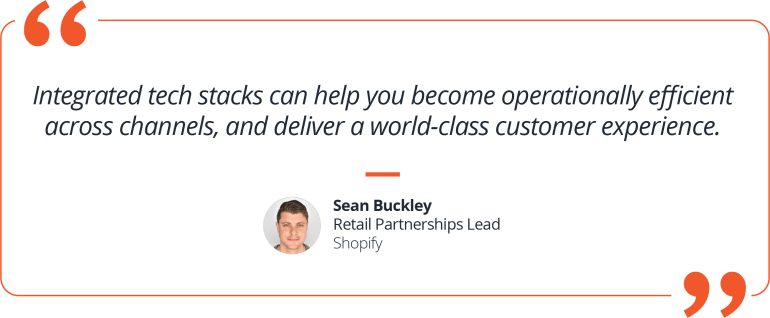
Pattern your omnichannel strategy after Disney. That’s an example I’ve thrown in here where they offer an immersive customer experience across their mobile app, website, and theme parks. Now, I know we’re just stores and we’re not necessarily Disney, but using an omnichannel technology stack and the solutions that are available in the market today, you can replicate that experience even at a single storefront that exists only online or in-person or both.
The Omnichannel Tech Stack Beyond Sales
Sean Buckley: The omnichannel tech stack isn’t just sales and customer focused. It also means managing inventory and fulfillment from all of your sales channels in a connected way. Omnichannel commerce means you’re managing inventory not only from online and retail stores, but also managing the inventory across your social channels. And this poses new challenges on inventory management and fulfillment for which you need the right tech stack. Centralizing your back-end operations can prevent margin erosion, inventory shortages, double selling, and costly logistic issues.
Inventory Management
Sean Buckley: Rather than managing inventory with a spreadsheet, an omnichannel inventory management tool equips you to manage inventory with real-time updating and inventory counts. This helps you have the right inventory in the right place at the right time which is crucial to executing your strategy across channels. It also allows you to consolidate your sales channels so you can manage every product, order, and customer in one place, or have a single source of truth to help you make smarter decisions.
Here are some of the benefits of having all of your inventory aggregated into one place:
- Real-time visibility into the inventory counts across all of your locations and channels.
- Synchronizing inventory counts across multiple locations and channels. It’s one thing to be able to see the inventory, it’s another for it all to be synced up.
- Automatically updating inventory counts across all channels with every sale.
If something sells on Facebook, all of your other sales channels know that that inventory has now decreased by what sold on Facebook. And the same thing goes for point of sale, and the same thing goes for online and for app marketplaces if you are integrated into them as well.
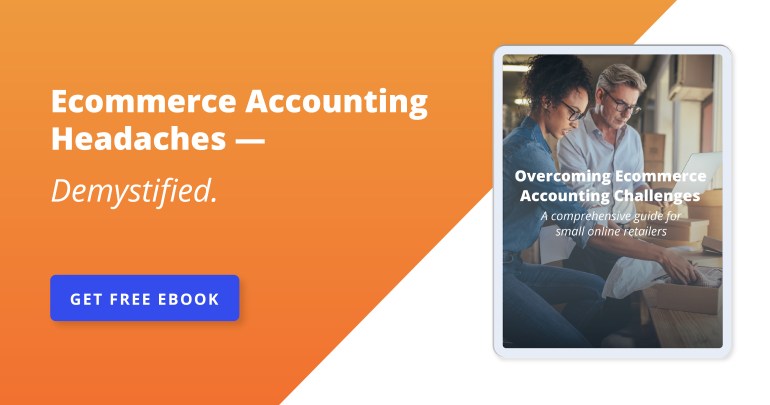
This helps reduce costly out-of-stocks, deadstock, and preventable returns. The new inventory quality you have available will be reflected across every sales channel connected to your system. And preventing those problems provides for a better customer experience, which impacts the post-purchase part of your sales funnel and makes your customers become repeat buyers and advocates.
By tracking your inventory turnover ratio to assess the health of your business, you can create rule-based order routing, and then accurately forecast demand and replenish inventory more efficiently, getting into more of a just-in-time model as opposed to having deadstock sitting on your shelves that might not have needed to be ordered. Your inventory system must integrate with your point of sale system to optimize your online-to-offline strategy. Integrated tech stacks can help you become operationally efficient across channels, and deliver a world-class customer experience.
Order Management
Sean Buckley: This is being able to see all of your orders and in-store sales from your channels in one place, both new and as a complete order history. If somebody made a purchase online and wants to return it in-store, it’s an easy order to look up and can be located from one database that’s interconnected across all of your sales channels.
Fulfillment
Sean Buckley: Understanding the state of an order from any channel is key. Has it been picked? Has it been shipped? Has it been delivered? Integrating your fulfillment to your inventory and order management allows for a customer experience that is consistent across all of your sales channels. And this is another key point. You want to make sure that in your omnichannel solution, purchasing from Facebook has the same shipping times and fulfillment experience as purchasing directly from your online website.
Customer Service
Sean Buckley: This is one that’s not always thought about but fits nicely into an omnichannel solution where everything is integrated, and the data and insights are being shared across all of your channels. Delivering a unified customer experience simultaneously across all channels means that you have to integrate your text, social, email, and instant messaging. Seamless integration allows a customer to switch between multiple channels without any degradation in quality of service.
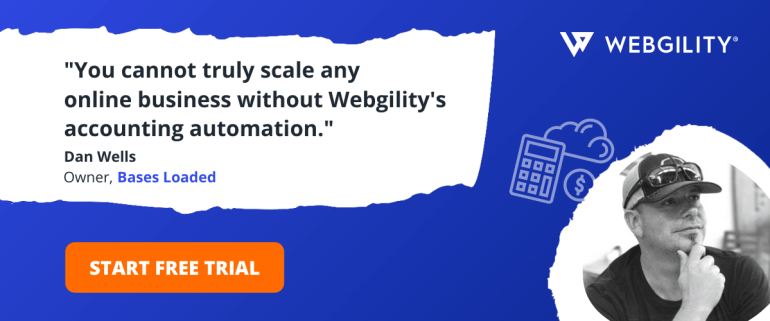
Connecting each touchpoint and being able to manage each from one dashboard, from one place, positions stores to support customers more quickly and more efficiently. Measuring results is vital to improving that omnichannel customer experience. Although customer expectations used to vary by channel, the majority now expect a real-time service regardless of channel. Customers spend more money and make more repeat purchases from stores that deliver excellent customer service. Unified communication starts with your customer relationship management platform. But customer service-only platforms can fill in any gaps that exist during and after a sale.
So I’ve talked about the three secrets of success, I’ve talked about some marketing tips and tricks that our top merchants are using, and then finally, a tech stack that helps tie it all together. I hope it has provided some insights into what our top merchants are doing in the market today, and ways that you can think of changing how you operate your business to maximise on the omnichannel opportunity. And from there, I will take it over to Q&A.
What are the most-used apps on Shopify stores and how can they help small businesses?
Sean Buckley: Oh, that’s a good question. I don’t have the exact data of what the top apps are in the store, but I can tell you that it usually goes around filling feature gaps or functionality. Shopify doesn’t do everything as a product. We do a lot, but we rely on partners like Webgility to add functionality and add those apps that we don’t have on our platform.
An example would be accounting integrations or sharing a data layer that Shopify doesn’t share within its core product. But a lot of this stuff like understanding that marketing journey, attribution of how a customer might have found your checkout, this can be provided by the insights that applications provide or post sale. When you’re actually managing operations or looking for insights, post-sale or in your business, a tool like Webgility will provide those additional insights to you, as well as help connect it to your other platforms say QuickBooks, for example, so you’re not doing double-entry accounting, and losing time and spending time there when you should be spending it in your storefront.
Other examples differ between what sales channels you’re using on Shopify. I focus on the brick-and-mortar world a little more than online. And in bricks and mortar, there’s all sorts of unique challenges a merchant might face that they don’t necessarily have online. One example would be staffing, or payroll, or staff scheduling, or even just understanding what your customer volume is coming through your doors. It’s easy to understand how many people visit your website; it’s a little tougher to count customers walking in and out and if they actually bought something. These are applications that are used there. But usually, connecting apps, inside applications, or apps that provide something unique to your business and what your business is looking for. And Shopify has got a great ecosystem to help provide that.
If I’m currently selling online and through a physical store, and use Shopify to sell online, how can I integrate the digital Shopify experience into my physical store today?
Sean Buckley: Shopify has an in-store point of sale system that integrates natively into our platform. If you think of one place that’s managing inventory, all of your customer and order data, and then that one place is connected to your online sales channel. And then Shopify point of sale is connected to all of that to facilitate your in-store selling and inventory management, and customer interactions in-store. That can all be interconnected natively on Shopify products. And then as an extension of that, Shopify has integrations in the marketplaces— eBay, for example, that integration is something where you can connect your Shopify platform to eBay. And all of a sudden, something that might sell there will reduce inventory on your point of sale and your online store in real-time. And there are examples of other types of sales channels that you can integrate, social being another one.
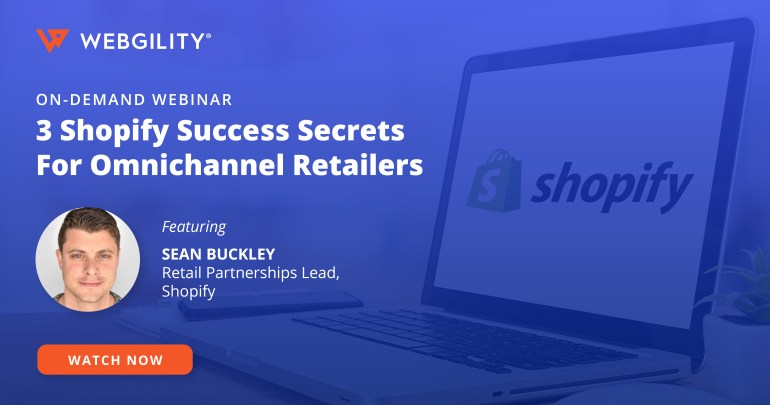
I’m selling on multiple channels, Amazon and Shopify. How do I get my data in both of these places into just one view? I’m so done with spreadsheets.
Sean Buckley: Some of those marketplaces, Shopify will integrate with through integrations that are readily available and free within the app marketplace, or that you can enable right within your Shopify UX/UI. Right within your user experience if you were to log in to your Shopify account, and then look at your user dashboard. And on the left-hand side, there should be a place to add sales channels. And you can connect to sales channels like eBay, or Amazon, or the social channels that I was mentioning in the presentation, right from within there. Or you can look at applications in the app marketplace that provide connections and probably provide an additional layer of value and insights depending on what your business needs are. Shopify does a lot, but we don’t do everything. And we rely on our application and technology partners to accelerate and be experts in those spaces. And some of that space is insights from those connections or facilitating those connections all together.
Anati Zubia: Yep. Absolutely. Another great example is actually something that Webgility does help with is product listing, inventory management, and helping get some of that financial data into your accounting system like QuickBooks. That’s something that we work closely with Shopify on to help consolidate that data and just get you out of those spreadsheets as you mentioned. It looks like we’re kind of right at the end of the time. I’ve got just one more question that I’ll cover.
What are the top signs that your business is not ready for omnichannel commerce?
Sean Buckley: Sign number one is that you might be selling on multiple channels. Meaning, you sell in person, you have an online store, you are maybe selling on social as well. But if they’re not interconnected, then you’re not able to take advantage of what omnichannel actually is, what the definition of it is. And that’s having all of those channels connected, sharing data, sharing insights with one another, and then actually being able to speak that data back to you. Number one would be if you have those channels active, but they’re not integrated in any manner, then you can’t really take an omnichannel strategy or an omnichannel approach.
Another one would be if you’re only selling on one channel. If you only sell in person or offline, then you need to investigate: How can I have another channel? How can I have another way to reach my customers when my store is closed? Online is an excellent example of being able to reach your customers 24/7. They can reach you by going directly to your website. And so when you investigate another sales channel to activate, now you have two ways to reach your customers.
And a great example is last year when so many merchants moved online for the first time because unfortunately, their stores were mandated to close, and their customers couldn’t come to their storefront. How could they reach their customers? How could they continue to sell to them either products or services when their stores were locked down? Well, open up a store that’s online and that’s available 24/7. And if you have the two, now you can say okay, how do I connect them? How do I make sure that they’re speaking to one another? And then I can look for the insights that Sean talked about earlier on the secrets to success. I can see, do they start visiting my website? Do almost all my customers go to my website first? Or do they start with my in-person store? Is my in-person store the magnet that creates the brand visibility of my store? Is it my billboard? And then I start moving those customers into online checkout. And what’s the percentage split? How many are shopping on one or the other? These are the things that I can go on forever about in the omnichannel world.
Anati Zubia: Awesome. Thank you so much, Sean. I definitely want to thank you so much for taking time out of your busy schedule to share all these insights today. On behalf of Webgility and Shopify, I just want to express my appreciation for everybody who took time today to join us. We’re definitely committed as a team to helping these businesses achieve that high growth, both online and in storefront, and really just fuel your profitability. Hopefully, we’ve been able to offer you all some actionable tips, something you could take back to your business and implement. But until next time, I’m wishing you guys all health and prosperity. Thank you for joining us today. Take care, everyone.
And now for attendee questions we were unable to answer during the live webinar:
What are the top 3-5 platforms every retailer should prioritize for their tech stack if they want to be successful in omnichannel?
Sean Buckley:
- A platform (like Shopify) that allows you to sell everywhere your customers are (ecommerce, social, marketplaces, in-store) and manage sales, orders, customers, inventory in one place.
- A platform that allows you to manage and gain insights on your omnichannel marketing strategy across all channels. The key difference this platform should provide is the ability to put the customer at the center of the strategy and offer them a seamless experience across all the sales channels they’re using.
- A platform that provides automation for your financial data, removing the need for double entry across your systems and helps prevent errors and data loss.
Beyond offering a unified customer experience, what’s the next trait most successful omnichannel brands have in common?
Sean Buckley: Most successful omnichannel brands are unifying their operational data and insights into one place. Beyond the customer-focused benefits, an omnichannel tech stack allows you to connect your business management and operations (e.g., inventory, order management, shipping, and customer service) together so that they can be managed more efficiently. This allows merchants to invest time and money into areas that help them grow sales that otherwise would have been used to just run the business day to day.
Monika Tripathi is a Sales Director at Webgility. She excels in driving revenue growth, building high-performing teams, and developing strategic partnerships across global markets.



.png?width=56&height=56&name=image%20(2).png) Monika Tripathi
Monika Tripathi